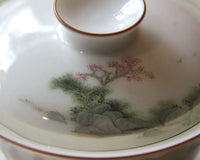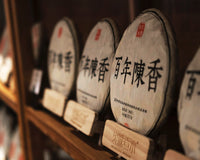Yixing Zisha Clay Teapots
ZiSha 紫砂 is one of the best and most renowned materials that teapots in China can be made from. The most famous source of ZiSha is YiXing city 宜兴市, formerly YangXian 陽羡 in JiangSu province.



What is Zisha Clay and where does it come from?
ZiSha is an ore that was formed around 350 million years ago. The ore consists of varying amounts of elements including quartz, kaolonite, mica, hematite (haematite) and iron. These elements when fired create a very strong and stable structure, that allows the wares to be resistant to temperature changes.
Unlike many clays that are extracted in a clay form, ZiSha starts out as a solid ore and is processed to form a course powder, to which water is added to create a clay.
The traditional process could take many years, even decades. The mined ore was traditional left in the open to weather and gradually breakdown into a gravel, it is believed that the longer the ore is left the better. The gravel is then ground into a sand to which water is added and worked until it creates a clay. This final clay is then stored underground, again for as long as possible to ensure the clay has the best possible working characteristics.


Processing
After processing the Zisha ore, the resulting Zisha clay features a naturally porous structure and very importantly naturally free from lead except for extremely low trace elements well below the most stringent EU/Japanese standards.
These natural properties means that Yixing Zisha Clay Teapots and even many cookery wares are naturally finished, without any glaze. The unglazed wares, with their natural porous characteristics mean that they benefit from regular use, absorbing some of the flavour & colour of the tea or food being prepared.
Especially with tea, over time, whether months or years it is believed that the quality of the tea that is made in the pot improves too. This, depending on many factors, means that prices for 'used' Yixing Zisha clay teapots can become astronomical.
Due to the exchange of flavours & colour it is typical that people have different teapots for different teas, for example one for Oolong, one for green tea and one for Pu Er. This approach has meant that many tea pots are specifically designed for specific teas. It is worth noting that teapots with wider openings are more suited for large leaf teas like old tree Puerh and Oolong teas which leaves expand considerably after water has been added. Each tea will season and age teapots in different ways, every preparation slowly being absorbed and bring about a marked change over time in colour and lustre. Regular use and care will ensure the Yixing Zisha clay teapot has a warmth radiating from it.
Interesting although zi sha literary means purple sand (clay), there is a diverse range of naturally occurring coloured clays available. These range from varying shades of brown and red, through black, green, and white.
It is highly recommended that if you purchase a Zi Sha teapot for drinking use that you first rinse it with boiling water before then preparing a good quality tea which should be left to stand for 12-24 hours prior to use. Alternatively, you should look at boiling the teapot in a pan of the chosen tea for 5-10 minutes, allowing the teapot to absorb the tea liquor. More details can be found in the following tea facts pages in our 'Preparing and caring for you Zi Sha teapot' guide.
Yixing Zi Sha teapots are produced in numerous styles and designs, available in different levels of quality and have prices that vary tremendously depending on the person who made it.

















